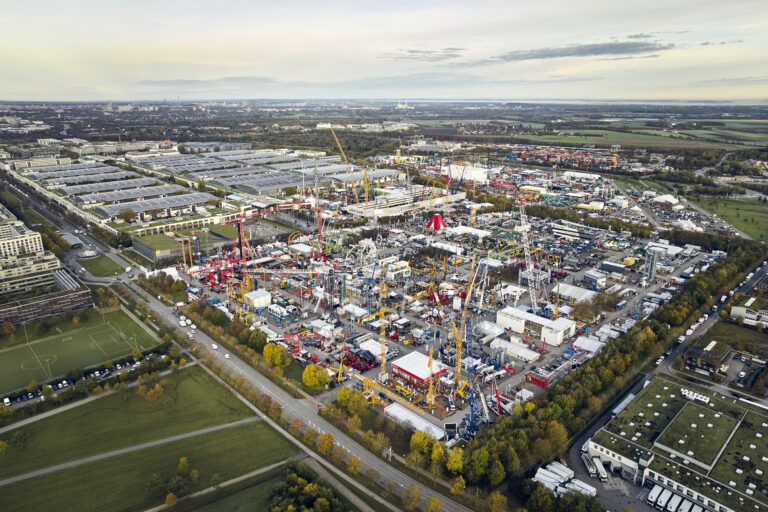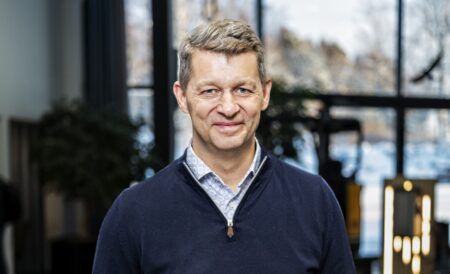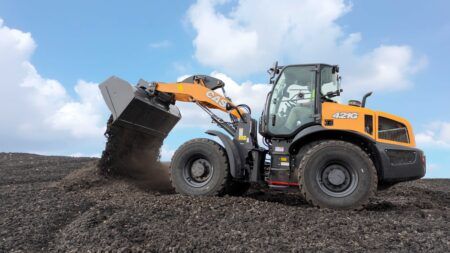Messe München CEO, Stefan Rummel and VDMA’s Joachim Schmid reveal more about what to expect from the 2025 edition of the world’s largest construction show and what it means to those involved and the wider industry
To organise the exhibition Messe München teams up with the VDMA, the German engineering federation (Verband Deutscher Maschinen- und Anlagenbau). “The cooperation between VDMA and Bauma started about 50 years ago,” says Joachim Schmid, MD of the VDMA’s construction equipment department. “Bauma know how to organise exhibitions, and we know about the hot topics, so we help organise the programme around Bauma.”
The VDMA helps to make Bauma more than just a trade show. “It’s a marketplace, not only in the sense of machines and goods that you can see and buy, but it’s also very important to exchange ideas within the industry every three years,” says Schmid. “Especially in these times… many things have to be discussed.”
With the usual spring event in 2022 delayed by the pandemic until the autumn that year, 2025’s gathering represents a return to the pre-Covid schedule, size and strength. “We are really happy that a lot of brands are back,” says Stefan Rummel, CEO of Messe München. “Size wise, we will have, once again, 614,000 square metres. A lot of brands are back who weren’t there in the pandemic, for example Volvo and CNH. Others will be there for the first time.”
A significant development for 2025 is a new entrance on the northeast side, designed to improve traffic flow around the massive exhibition. “We bought some land on the other side and created a multi-functional area where coaches arrive. We built a bridge over to the fairground for a new entrance, to ease the traffic situation,” says Rummel. “Basically, we are building a small city within Munich when we create this show, and you have to improve the infrastructure step by step every year. We have a team specialised in security, logistics and traffic. We even have our own fire station and our own Lufthansa counter.”
Mission: emissions
One of the key topics in discussion both in the Bauma Forum and on stands around the fairgrounds will be electrification and alternative fuels. You can see just some of the new vehicles that will be launched in this area on the following pages.
Exciting as they are, Schmid is aware that battery solutions won’t be the whole picture when it comes to decarbonizing off-highway vehicles. “Often we are compared with the automotive industry, but construction equipment is really completely different,” he says. “It’s okay for cars to have battery electric solutions, but it’s definitely not enough for construction equipment. Our machines are bigger, mostly they need a lot of energy, and at least today, you cannot build the batteries in such a size that the machine can work at its optimum for the whole day. For construction sites downtown you might have smaller machines. But if you go road building in the middle of nowhere, you have no electricity.”
Innovation and growth
This partnership between VDMA and Messe München has evolved into a comprehensive approach to industry innovation, with VDMA taking a leading role in several key initiatives. “We have the startup engine from VDMA with about 45 startups showing what they can do,” says Schmid. “We have an initiative in digitization, the Machines in Construction 4.0 (MiC 4.0) which is a really big deal. It started in 2019 and we’ve worked on it for five years. Last summer we reached a goal as we opened up the test software for machines – we’ve now got MiC 4.0 bus, which means plug and play for construction attachments. No matter what make or company, the MiG 4.0 definition means plug and play.”
Hall B0 serves as the event’s innovation centre, hosting the Science Hub with 10-12 universities, a startup area with approximately 45 new companies, and the Bauma Forum for daily themed discussions. “The universities come with exhibits and show what they are working on. This is so important, especially in these times where innovation is so important,” says Schmid.
The Think Big initiative also continues to grow and is expecting to attract 15,000 students in 2025. “We have a dedicated area in the Congress Centre, adjacent to Hall B0, and we have workshops there with several machines,” says Schmid. “Young people work on the machines, we have moderators, and several companies inform about the growing number of possibilities in our industry.”
As the big event draws closer, over 3,500 exhibitors must work closely together with the organisers and with each other, cooperating on the set-up process, which begins weeks before the opening with heavy trucks delivering to outdoor areas from the start of March. It all leads to a crescendo as the final hours and minutes before opening tick away. “If you walk around on Sunday, you think, ‘This will never get finished’,” says Rummel. “But there’s always something happening during that last night before opening day and it will be ready on Monday morning.”
This article first appeared in the March issue of iVT





